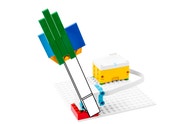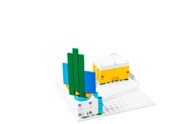Good Morning Machine
Help Leo say ‘good morning’ to his friends!

Prepare
- Review the Good Morning Machine lesson in the LEGO® Education SPIKE™ App.
- If you feel that it would be beneficial, pre-teach these related vocabulary words: challenge, create, innovate, program, test and upgrade.
- Consider the abilities and backgrounds of all your pupils. Differentiate the lesson to make it accessible to everyone. Please refer to the Differentiation section below for suggestions on how to do this.
- If time permits, plan and facilitate the language arts extension. Please refer to the Extension section below for further information.
Engage
(Whole Class, 5 Minutes)
- Facilitate a quick discussion about the process of identifying the steps that must be followed in order to solve a problem.
- Talk with your pupils about what they would do if they had to reach something that was too high.
- Ask questions like these: What would you do first? What would happen after that?
- Introduce your pupils to the story’s main characters and the first challenge: starting the waving machine for Leo.
- Distribute a brick set and a device to each group.
Explore
(Small Groups, 30 Minutes)
- Have your pupils use the LEGO® Education SPIKE™ App to guide them through their first challenge:
- Create and test the program that starts the waving machine.
- Have your pupils iterate and test their models to complete the next two challenges in the app:
- Upgrade the program for the waving machine.
- Design your own waving machine.
- You can find coding and building help in the Tips section below.
Explain
(Whole Class, 5 Minutes)
- Gather your pupils together to reflect on their completed challenges.
- Ask questions like these: What was Leo’s problem? How did you help him to solve it? How did you improve Leo’s waving machine?
Elaborate
(Whole Class, 5 Minutes)
- Prompt your pupils to discuss and reflect on ways of defining and understanding a problem.
- Ask questions like these: Why is it important to understand the problem you are trying to solve? What types of questions should you ask to find out more about the problem?
- Have your pupils tidy up their workstations.
Evaluate
(Ongoing Throughout the Lesson)
- Ask guiding questions to encourage your pupils to ‘think aloud’ and explain their thought processes and reasoning in the decisions they have made while building and programming their models.
Observation Checklist
- Measure your pupils’ proficiency in defining and understanding the given problem.
- Establish a scale that suits your needs. For example:
- Requires additional support
- Can work independently
- Can teach others
Self-Assessment
Have each pupil choose the brick that they feel best represents their performance.
- Yellow: I think that I can define and understand the problem.
- Blue: I can define and understand the problem.
- Green: I can define and understand the problem, and I can also help a friend to do it.
Peer Feedback
- In their small groups, have your pupils discuss their experiences working together.
- Encourage them to use statements like these:
- I liked it when you…
- I would like to hear more about how you…
Tips
Coding Tips
- After your pupils have completed their first challenge, they will be provided with a map.
- Using the map, your pupils can experiment with the available Coding Blocks to modify their programs to follow the route for the trip.




Model Tip
- After your pupils have completed their second challenge, they will be provided with three Inspiration Images and an open-ended prompt, which will help them to improve their models.
- The Inspiration Images are meant to help spark their imaginations as they experiment and personalise their models.




There are no specific building instructions for this challenge.
Differentiation
Simplify this lesson by:
- Selecting one Inspiration Image to help your pupils personalise their models
- Experimenting with either the coding or the building
Increase the difficulty by:
- Exploring new and different coding blocks within the program
- Including another motor or sensor in the waving machine's design
Extension
- Have your pupils conduct a short research project about how people from different cultures greet each other in the morning.
If facilitated, this will extend beyond the 45-minute lesson.
ACELA1476
Understand that successful cooperation with others depends on shared use of social conventions, including turn-taking patterns, and forms of address that vary according to the degree of formality in social situations.
Teacher Support
The pupils will:
- Define and understand a problem
- Brainstorm and iterate in order to create a solution that meets the described needs
- Engage effectively in a range of collaborative discussions
(one for every two pupils)
- LEGO® Education SPIKE™ Essential Set
- Device with the LEGO® Education SPIKE™ App installed
Design and Technologies
ACTDEP015
Generate, develop, and communicate design ideas and decisions using appropriate technical terms and graphical representation techniques.
Digital Technologies
ACTDIP013
Plan, create and communicate ideas and information independently and with others, applying agreed ethical and social protocols.
English Language
ACELA1476
Understand that successful cooperation with others depends on shared use of social conventions, including turn-taking patterns, and forms of address that vary according to the degree of formality in social situations.




